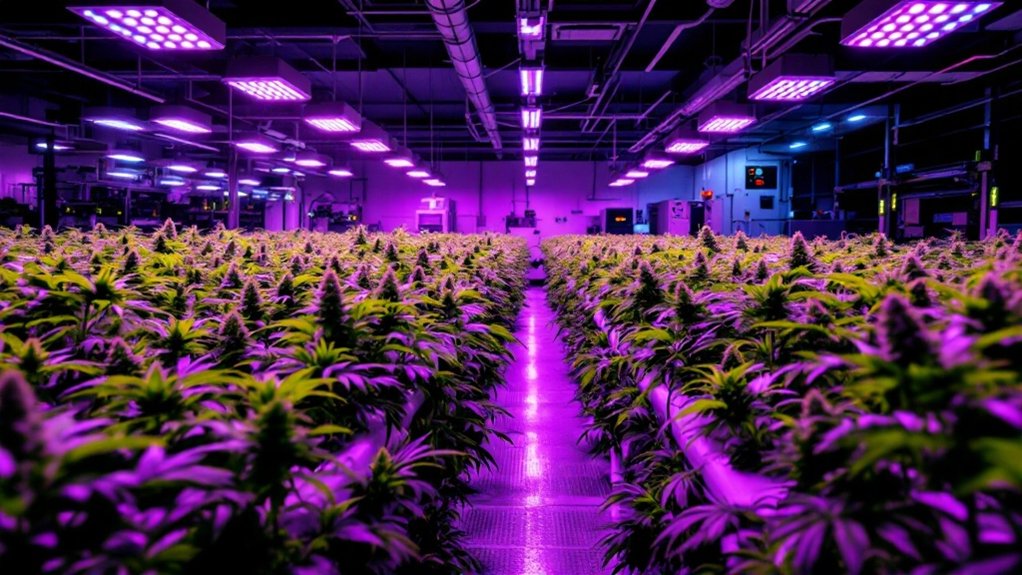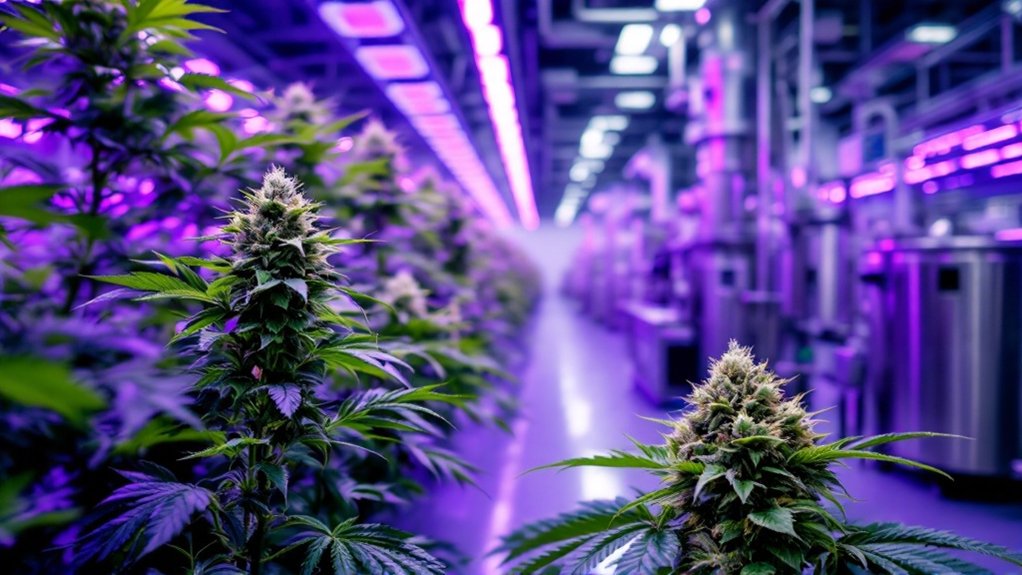Commercial cannabis growers boost profits through multiple strategic approaches. Vertical farming and environmental controls maximize yield per square foot, while energy-efficient LED lighting and water recycling systems reduce operational costs. Advanced automation decreases labor expenses, and product diversification into extracts, edibles, and beverages expands revenue streams. Data-driven crop analytics and cannabis management software optimize inventory and guarantee compliance with regulations. These integrated strategies position cultivators to capitalize on the industry’s projected growth to $38.32 billion by 2025.

Cultivating profitability in the cannabis industry requires a strategic approach that extends beyond simply growing plants. Commercial growers increasingly leverage advanced cultivation techniques to maximize yield per square foot, a vital metric in this space-constrained industry. Hydroponic and aeroponic systems allow plants to grow more densely while vertical farming methods can triple the effective growing space without expanding the facility’s footprint.
These methods, combined with optimized environmental controls that precisely manage CO2 levels, temperature, and humidity, create ideal growing conditions that greatly enhance harvest consistency.
Cost reduction represents another vital avenue for improving margins in cannabis operations. Energy-efficient LED lighting systems reduce electricity consumption while simultaneously enhancing plant growth cycles through customized light spectrums. Integrated pest management protocols minimize reliance on expensive chemical treatments, while water recycling systems can dramatically reduce utility expenses. The cannabis industry is projected to create over 500,000 jobs by 2025, making efficiency crucial for operations scaling to meet market demand.
Smart cost management isn’t just saving money—it’s enhancing growth potential while reducing environmental impact
Many successful operations implement automation technologies for irrigation and nutrient delivery, reducing both labor costs and resource waste through precise application timing.
The market expansion beyond traditional cannabis products offers substantial revenue opportunities. Extraction facilities enable the production of oils and tinctures, which constituted 53.1% of medical market revenue in 2022. Concentrates, edibles, and beverages reach broader customer segments, particularly those who prefer not to smoke. With cannabis beverages experiencing 11% sales growth in the year ending June 2024, this category represents a promising diversification strategy.
Branded products with distinctive packaging and consistent quality build customer loyalty and command premium pricing in an increasingly competitive marketplace.
Technology investments deliver considerable returns for cannabis cultivators. Automated trimming, packaging, and labeling systems increase throughput while reducing labor costs and human error. Cannabis management software optimizes inventory control and compliance documentation, while data-driven crop analytics predict yields and identify opportunities for process improvement.
RFID tracking systems provide enhanced supply chain visibility and satisfy regulatory requirements for seed-to-sale tracking.
Market awareness remains essential for sustainable profitability. The cannabis recreational market is projected to reach $38.32 billion by 2025, with online sales expected to increase by 300% during the same period. Consumer demographics continue to evolve, with user bases anticipated to double to 40 million by 2028.
Commercial growers who maintain rigorous quality standards through third-party testing while adapting quickly to regulatory changes position themselves advantageously in this dynamic marketplace. Strategic partnerships with retailers, processors, and other brands further expand market reach and distribution capabilities.
Frequently Asked Questions
What Insurance Options Protect Against Crop Failure?
Cannabis cultivators have several insurance options to protect against crop failure.
Specialized Cannabis Crop Insurance policies cover living plant material against fire, theft, and natural disasters from seed to sale.
Multi-Peril Crop Insurance (MPCI) specifically addresses multiple risks like drought, freeze, and crop diseases, particularly beneficial for outdoor operations.
Property and Business Interruption Insurance helps maintain cash flow if crop failure halts production, ensuring financial stability and business continuity after major loss events.
How Do Tax Regulations Differ Across States for Cannabis Businesses?
Cannabis tax regulations vary dramatically across states. Excise tax rates range from 10% in Minnesota to 16% in Arizona, with standard sales taxes applied additionally.
Section 280E prohibits federal deductions beyond cost of goods sold, though 22 states allow ordinary business expense deductions on state returns.
Medical cannabis typically receives preferential tax treatment compared to adult-use products.
The complexity of these systems requires businesses to maintain detailed compliance monitoring as tax structures frequently change.
Which Pest Management Solutions Minimize Crop Contamination Risks?
Commercial cannabis growers minimize contamination risks through integrated pest management strategies that reduce chemical interventions.
Biological controls like predatory insects and physical barriers including air filtration systems provide effective alternatives to traditional pesticides. Maintaining ideal humidity and temperature settings naturally discourages pest proliferation.
When intervention is necessary, growers utilize low-risk products such as insecticidal soaps, horticultural oils, and targeted biological pesticides like Bacillus thuringiensis, which degrade rapidly and don’t persist on harvested material.
What Employee Training Programs Maximize Workforce Efficiency?
Effective employee training programs that maximize workforce efficiency include technical skills certification in cultivation, extraction, and retail operations.
Structured courses combine online learning with hands-on practice to develop job-ready abilities. Programs incorporating Lean operations principles, standard operating procedure training, and data-driven decision making greatly increase productivity.
Additionally, business development tracks, compliance training, and technology upskilling prepare workers to handle cultivation software and inventory management systems, creating a more adaptable and solution-oriented workforce.
How Do Relationships With Dispensaries Affect Wholesale Pricing Strategies?
Strong relationships with dispensaries greatly impact wholesale pricing strategies for cannabis growers.
These partnerships enable negotiation of favorable tiered pricing agreements based on purchase volumes and consistency. Dispensaries often grant preferred vendors priority shelf space and exclusive contracts, stabilizing income while reducing price volatility.
Data sharing between growers and retailers supports dynamic pricing based on real-time demand and inventory turnover.
Additionally, collaborative risk mitigation through consignment arrangements and flexible payment terms helps maintain higher average wholesale prices despite market fluctuations.









